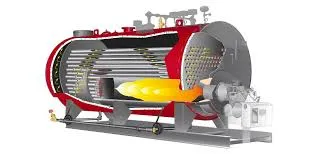
अक्ट . 14, 2024 22:03 Back to list
Different Types of Steam Boilers and Their Applications in Various Industries
Understanding Steam Boiler Types A Comprehensive Overview
Steam boilers are indispensable components in various industries, providing essential heating and power generation services. The choice of boiler type is critical, as it can significantly impact efficiency, safety, and operational costs. This article explores the different types of steam boilers, their characteristics, and applications.
1. Fire-Tube Boilers
Fire-tube boilers are one of the most common types used in various industries. In this design, hot gases from the combustion process flow through tubes that are submerged in water. The heat from the gases is transferred to the water, generating steam. Fire-tube boilers are generally simpler in design, making them easier to operate and maintain. They have a lower pressure limit, typically up to 300 PSI, which makes them suitable for applications requiring low to medium steam pressure.
One of the key advantages of fire-tube boilers is their quick start-up time and efficient heating. They are often used in small to medium-sized applications, including residential heating, food processing plants, and breweries.
2. Water-Tube Boilers
In contrast to fire-tube boilers, water-tube boilers feature water-filled tubes that are heated by combustion gases on the outside. This design allows water-tube boilers to operate at much higher pressures, sometimes exceeding 1,200 PSI. Their ability to generate steam quickly and efficiently makes them ideal for power generation plants and large industrial processes.
Water-tube boilers are known for their excellent heat transfer abilities and compact design. They occupy less space compared to fire-tube boilers, which is crucial in facilities where space is limited. However, they can be more complex to operate and require more extensive maintenance.
Electric boilers use electric heating elements to generate steam. They are particularly useful in locations where a reliable supply of electricity is available but natural gas or oil is not. Electric boilers are more environmentally friendly, producing no emissions. They are easier to operate and maintain due to fewer moving parts.
steam boiler types

These boilers are typically used in smaller applications, such as district heating, commercial buildings, or for process heating in various industries. While they have higher operating costs in terms of energy consumption compared to fossil-fuel boilers, they provide precise temperature control and can be highly efficient.
4. Combination Boilers
Combination boilers, or combi-boilers, offer the functionality of both instantaneous water heating and steam generation. This versatility is especially beneficial in residential settings where space is at a premium. Combi-boilers can provide both hot water for heating and hot water for domestic use.
These boilers are increasingly popular due to their compactness and effectiveness, although they might not be suitable for larger industrial applications. Users need to evaluate their hot water and steam requirements carefully to ensure the right size and capacity are chosen.
5. High-Pressure Steam Boilers
High-pressure steam boilers are specialized types designed to operate at pressures above 15 PSI. These are essential in environments that require steam for process heating, power generation, and other industrial applications where higher temperatures and pressures are necessary.
These boilers can be either fire-tube or water-tube designs, depending on the operational needs. Their complexity and the risks associated with high-pressure operation necessitate stringent safety measures and regulation compliance.
Conclusion
Choosing the right type of steam boiler is crucial for optimizing energy efficiency, reducing costs, and ensuring effective operations in various applications. Fire-tube and water-tube boilers are the most common, each offering distinct advantages depending on the specific requirements. Electric and combination boilers present viable options for smaller settings, while high-pressure steam boilers cater to industries requiring elevated operational parameters. As technology continues to evolve, understanding these types and their applications will help businesses make informed decisions to enhance their operations.
-
Efficient Biomass Fired Hot Water Boiler | AI Heating Solution
NewsAug.01,2025
-
High-Efficiency Gas Thermal Oil Boilers | HPT Models
NewsJul.31,2025
-
Oil Fired Hot Water Boilers Sale - High Efficiency & Affordable
NewsJul.31,2025
-
High-Efficiency Commercial Oil Fired Steam Boiler for Industry
NewsJul.30,2025
-
High-Efficiency Biomass Fired Thermal Oil Boiler Solutions
NewsJul.30,2025
-
High Efficiency Gas Fired Thermal Oil Boiler for Industrial Heating
NewsJul.29,2025
Related PRODUCTS






















